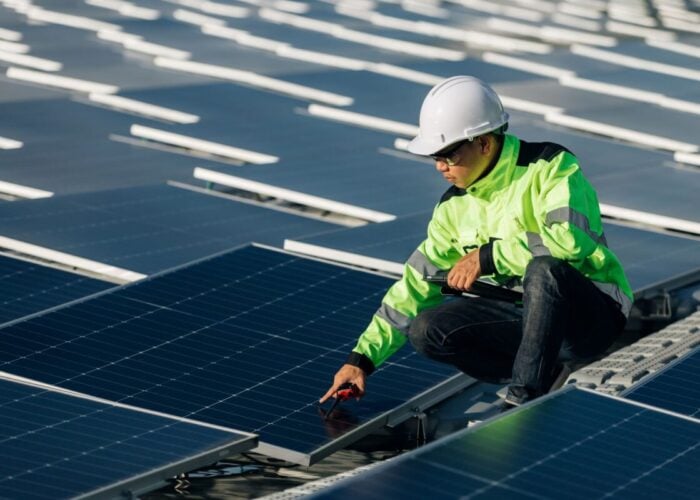JinkoSolar had been a laggard amongst its major rivals in R&D expenditure since the company started production and was only beaten to the bottom ranked position within PV Tech’s 2013 annual R&D expenditure report by Suntech, due to its bankruptcy.
Unlock unlimited access for 12 whole months of distinctive global analysis
Photovoltaics International is now included.
- Regular insight and analysis of the industry’s biggest developments
- In-depth interviews with the industry’s leading figures
- Unlimited digital access to the PV Tech Power journal catalogue
- Unlimited digital access to the Photovoltaics International journal catalogue
- Access to more than 1,000 technical papers
- Discounts on Solar Media’s portfolio of events, in-person and virtual
With Wuxi Suntech's R&D spending in 2014 reported at US$2.1 million, JinkoSolar is no longer the laggard.
A part of the significant increase in R&D expenditure was the increase in employees dedicated to R&D activities, which had been cut in 2013 to 125 but expanded in 2014 to 160 personnel. JinkoSolar’s peak R&D headcount was in 2010, when R&D staffing levels topped 342.
The increase in R&D focus can also be measured in IP patent activity. JinkoSolar had been granted a total of 87 patents in China at the end of 2013 and 89 patent applications pending.
At the end of 2014, JinkoSolar had been awarded 130 patents while a further 156 patent applications were pending.
Cell efficiency boost
Further confirmation that JinkoSolar is making strides with solar cell technology was the hike in average cell efficiencies, notably for monocrystalline cells.
Indeed this is significant for the company having had average monocrystalline cell efficiencies stagnant since 2012.
However, in contrast, JinkoSolar has only achieved minor incremental efficiency gains with its multicrystalline solar cells, taking average cell efficiencies from 17.6% in 2012 to 18.2% by the end of 2014.
Yet, JinkoSolar may be able to boost multicrystalline cell efficiencies at a faster pace in 2015, due to its recent announcement to start ramping 450MW of high-efficiency Passivated Emitter Rear Cell (PERC) capacity at its new production plant in Malaysia.
The company has also recently announced a strategic collaboration agreement with DuPont for the implementation of next-generation metallization pastes, using DuPont’s PERC specific ‘Solamet PV19x’ series pastes.
It should be noted that JinkoSolar was never a laggard when it came to cell efficiencies, having benefitted from being one of the last PV manufacturers to aggressively expand capacity in 2011 and 2012, using the latest cell technology that was available from leading equipment suppliers, before overcapacity took its toll on the industry.
With manufacturing cost reductions significantly slowing due to the bottoming of material costs for the likes of polysilicon and silver pastes as well as a slowdown in quality improvements with multicrystalline silicon wafers, emphasis looks increasingly focused on cell efficiency gains.
These cost per-watt gains are being enabled by second-generation PERC cell technology to provide low-cost leaders such as JinkoSolar with the room to continue on cost reduction roadmaps.
The company is targeting high-efficiency cells and modules at its new Malaysian plant that will start ramping in May, primarily for the US market this year and has a program to further upgrade selected lines in China.
However, one of the surprises in the annual report was not the emphasis on improving cell efficiencies but the stated strategy shift away from capacity expansions in favour of cell/module efficiencies.
The company even went far enough to warn that previously placed equipment purchase orders and prepayments, primarily to expand capacity in China could be cancelled or deferred that could also lead to late charges or forfeiture of prepayments.
Capital expenditure
Although JinkoSolar has continued to expand capacity in recent years, it has not been the biggest spender, indeed it has the ability to spend very little for the actual gain in nameplate capacity.
The company had purchase capital commitments of US$76.6 million at the end of 2014, with the majority payable in 2015. This is believed to primarily relate to equipment purchased for the new Malaysian fab and indicates how cheap a 500MW cell and 450MW module plant has become.
JinkoSolar also highlighted that its top three equipment suppliers in 2014, included Wuxi Autowell Technology, Yingkou Jinchen Machinery and Shanxi Hermaion Solar that combined supplied 28.8% of equipment and spare parts to the company.
Tight control of capital spending for production purposes may remain in place but the company actually had capital expenditures of US$485.3 million in 2014.
However, the caveat here is that the vast majority was allocated to its downstream PV power plant business as the company built and retained on its balance sheet ahead of a planned yieldco IPO sometime in 2015.
The company completed 290MW of PV projects in 2014, up from 230MW in 2013. Although it missed its planned installation target by a wide margin last year, guidance was recently given that it would achieve its 2015 guidance range of 600-800MW, having expected module shipments to its own downstream projects in China to be in the range of 160MW to 180MW in the first quarter of 2015. This would result in having 350MW of projects registered on the subsidy catalogue in China in the same quarter.
As with many other PV manufacturers building a business in the downstream market balancing capital spending between manufacturing capacity expansions and PV projects is proving to be a balancing act with limited funds.






